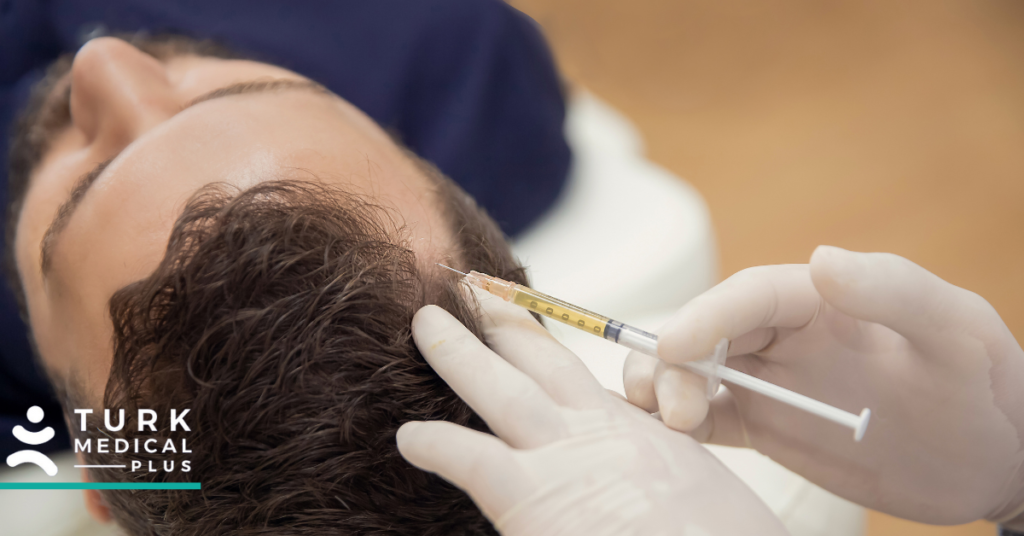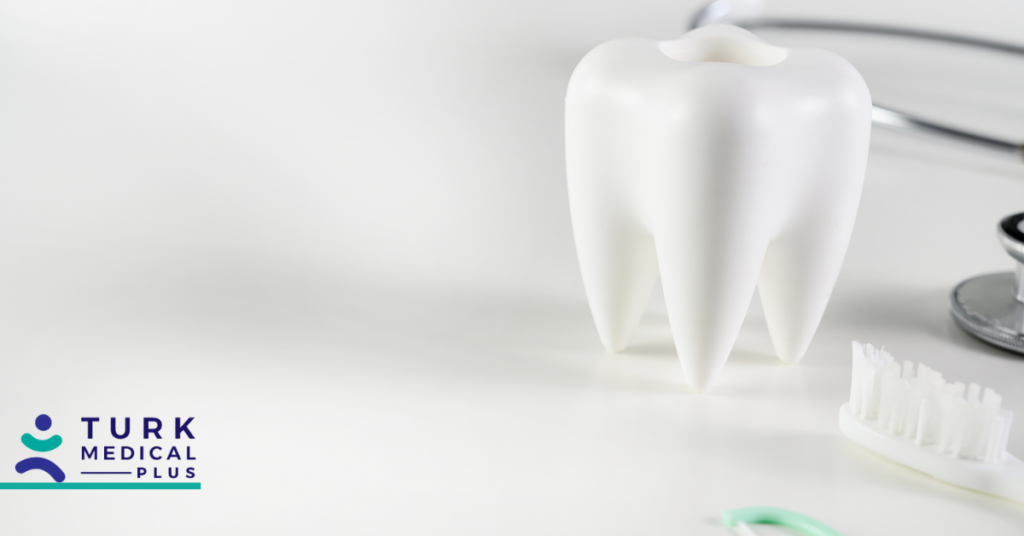1.1 The concept of platelet rich plasma (PRP) therapy
Platelet Rich Plasma (PRP) therapy is a medical procedure used to stimulate tissue growth and promote healing in various areas of medicine, including hair transplantation and dermatology.
The treatment depends on the extraction of blood plasma and its concentration in platelets, which are rich in growth factors and biologically active proteins.
In this procedure, a small amount of blood is drawn from the patient and then concentrated using certain methods to obtain platelet-rich plasma.
The benefits of platelet rich plasma are that it contains many important protein and developmental factors that contribute to promoting healing and tissue regeneration.
After the platelet rich plasma is concentrated, it is injected directly into the targeted treatment area.
It is believed that platelets stimulated with growth factors can promote cellular regeneration and stimulate blood vessel growth and cellular communication, resulting in improved tissue health and stimulation of hair growth and skin regeneration.
Platelet rich plasma therapy is used in various fields such as hair transplantation, skin beautification, skin wound treatment and wound healing, treatment of wrinkles and signs of aging, treatment of infections and sports injuries, and others. The procedure is safe and painless, as the patient’s own blood is used, which reduces the risk of allergy or infection. However, obtaining visible results may require several treatment sessions.
Definition of platelet rich plasma and its components:
Platelet Rich Plasma (PRP) is a component of blood, consisting of concentrated blood plasma that has a high concentration of platelets.
Platelets are part of the white and red blood cells and platelets, but they contain a rich content of growth factors and biologically active proteins.
Platelet-rich plasma contains several important components, including:
- Platelets: Platelet-rich plasma contains a high concentration of platelets, which are small cells of great importance in the process of cellular renewal and wound healing.
- Developmental factors: Platelets contain many important developmental factors, such as platelet-derived growth factor (PDGF), human plasma growth factor (HGF), and vascular endothelial growth factor (VEGF).
These factors contribute to stimulating blood vessel growth, wound healing, and tissue regeneration.
- Bioactive Proteins: Platelet Rich Plasma also contains a variety of bioactive proteins that play a role in promoting healing and tissue regeneration.
These are the main components of PRP responsible for its therapeutic effects in different areas such as hair transplantation, skin aesthetics, and surgical healing.
They are used to take advantage of their regenerative and healing capabilities.
How to extract platelet rich plasma
Platelet rich plasma extraction involves a simple process that includes the following steps:
- Blood draw: A small amount of blood is drawn from the patient using a thin, clean needle. Blood is most often drawn from a vein in the arm.
- Plasma concentration: The sample taken from the blood is placed in a tube or instrument called a centrifuge.
The sample is rotated at high speed to separate the plasma from the rest of the blood components.
- Platelet Rich Plasma Collection: Once the platelet rich plasma has been separated, it is collected using a syringe or a special instrument.
The focus is on collecting only the platelet-rich plasma, leaving out the other components of the blood.
- Platelet Rich Plasma Processing: Special devices can be used to process platelet rich plasma to increase the concentration of platelets in it. This is done by concentration or dilution, depending on the target disease and therapeutic requirements.
These steps aim to extract and concentrate platelet-rich plasma in a manner that allows maximum utilization of platelets and the growth factors present in them.
This work should be done under the supervision of a specialist in accordance with appropriate medical guidelines.
1.2 Benefits of Platelet Rich Plasma (PRP) Therapy
Platelet Rich Plasma (PRP) is believed to stimulate hair growth and strengthen hair follicles thanks to its high concentration of growth factors and biologically active proteins.
Its potential effects include:
- Stimulate blood vessels: The growth factors found in platelet rich plasma are thought to stimulate the growth of blood vessels in the scalp.
Thus, the scalp is supplied with more oxygen and essential nutrients to the hair follicles, which promotes hair growth and strength.
- Stem Cell Stimulation: Platelet Rich Plasma contains growth factors that activate and stimulate stem cells in the scalp.
This enhances the activity of the hair follicles and contributes to hair renewal and growth.
- Improve the condition of the scalp and skin: Platelet Rich Plasma contains biologically active proteins that promote healthy scalp and surrounding skin. When the scalp and skin are in good health, an environment is created for the growth of strong, healthy hair.
- Strengthening hair follicles: The growth factors in platelet rich plasma are believed to help strengthen hair follicles and improve their quality. Thus, hair loss can be reduced and the existing hair can be enhanced. With increased research and development in this area, it is expected to improve our understanding of the mechanism by which platelet rich plasma stimulates hair growth and strengthens hair follicles. However, keep in mind that the results of PRP treatment may vary from person to person and may be affected by factors such as the cause of hair loss and the individual’s health condition.
– Improve hair density and its general appearance
Improving hair thickness and overall appearance is an important goal for many people who suffer from hair loss. It is believed that platelet-rich plasma (PRP) can contribute to this through the following effects:
- Increase hair density: Platelet Rich Plasma contains growth factors and proteins that are believed to stimulate hair growth and enhance the activity of hair follicles.
These factors can contribute to thicker hair and improve its overall appearance.
- Improve hair quality: The growth factors found in platelet rich plasma are believed to enhance overall hair quality.
It may contribute to improving the strength and elasticity of hair, reducing breakage, and improving its shine.
- Improve the condition of the scalp: Maintaining the scalp is an important health point of view to maintaining healthy hair.
Platelet Rich Plasma can improve scalp condition by promoting sebum balance and hydration, reducing inflammation, and promoting healthy skin in this area.
Platelet Rich Plasma aims to stimulate the growth of healthy hair and improve its quality and overall appearance.
However, keep in mind that treatment results may vary from person to person and depend on several factors, including the cause of hair loss, the individual’s health condition, and their personal response to treatment.
– Improve scalp health and combat irritation and dandruff
Platelet Rich Plasma (PRP) can improve scalp health and combat irritation and dandruff through the following effects:
- Sebum balance: PRP contains growth factors and proteins that promote sebum balance in the scalp. They may help regulate sebum production and reduce the chance of excess build-up, which improves scalp health and reduces the chances of irritation and dandruff.
- Reducing inflammation: Platelet-rich plasma contains growth factors and anti-inflammatory proteins that are believed to help reduce inflammation in the scalp. Thus, it may reduce irritation and redness caused by chronic inflammation.
- Improved scalp hydration: The growth factors present in platelet rich plasma are thought to contribute to improved scalp hydration. May boost skin moisture and reduce scalp dryness and flaking.
- Stimulate the growth of healthy cells: Platelet Rich Plasma contains growth factors that promote the growth of healthy cells in the scalp.
This promotes the restoration and regeneration of the skin and the strengthening of the scalp.
With regular use of Platelet Rich Plasma, scalp health can be improved and irritation and dandruff can be combated.
However, keep in mind that their effects may vary from person to person and depend on several factors, including the cause of the irritation, the individual’s state of health, and their personal response to treatment.
It is advised to consult with a healthcare professional to determine the appropriate treatment for your condition.
1.3 Platelet Rich Plasma (PRP) Treatment Process
– Perform blood extraction and platelet-rich plasma processing
The process of extracting blood and preparing platelet rich plasma (PRP) includes the following steps:
- Blood extraction: A small amount of blood is drawn from the patient, usually from a vein in the arm. A thin, clean needle is used to draw blood.
- Rotatable tube preparation: The extracted blood is placed in a special rotatable tube. The tube contains an anticoagulant to keep the dummy fluids from clotting.
- Centrifugation process: The tube is placed in a centrifuge. The machine runs at a specific speed to separate the platelet-rich plasma from the red part of the blood.
- Platelet-rich plasma collection: After centrifugation, the concentrated platelet-rich plasma is collected in a certain part of the tube. Emphasis is placed on collecting platelet-rich plasma only and avoiding collection of the blood red portion.
- Platelet Rich Plasma Preparation: It may require a specific technique to prepare and further concentrate the platelet rich plasma. This is done by adding activators or controlling the speed and centrifugation time. Clean and sterile equipment and tools must be used during this procedure to ensure patient safety. The procedure should be performed by a qualified health professional as per appropriate medical guidelines.
– Re-injection of plasma into the scalp and targeted baldness areas
After platelet rich plasma (PRP) has been extracted and prepared, it is re-injected into the scalp and targeted balding areas.
The process includes the following steps:
- Clean the skin: The scalp and the targeted baldness areas are thoroughly cleaned with an antiseptic solution to ensure that the skin is clean before injection.
- Area anaesthesia: A local aesthetic may be applied to the scalp or local anaesthesia may be given by injection to reduce pain and discomfort during the procedure.
- Injection: A fine needle is used to precisely inject platelet rich plasma into the scalp and targeted balding areas.
The areas that need treatment are identified and the platelet rich plasma is injected into the appropriate depths of the scalp and hair follicles.
- Frequency of sessions: Platelet Rich Plasma treatment can be a multi-session process, where injections are repeated at specific intervals, usually every month or as recommended by the attending physician.
The number of sessions and intervals depends on the patient’s condition and response to treatment.
After injection, a short period of time should be waited to allow the platelet rich plasma to absorb and affect the hair follicles.
It is important to note that the results of PRP treatment may vary from person to person, and it may take some time to notice an improvement in hair growth and density.
It is advised to follow the directions of the specialist doctor and repeat the treatment regularly to achieve the best possible results.
Post-treatment directions and expected results:
After a Platelet Rich Plasma (PRP) hair transplant treatment, it is important to follow the necessary directions to ensure the best results and enhance the effect of the treatment. Here are some post-treatment guidelines:
- Avoid touching the scalp: You should avoid touching or rubbing the treated scalp for a certain period after treatment. It is advised not to twist or vigorously move the hair for 24-48 hours.
- Avoid strenuous physical activities: It is recommended to avoid strenuous physical activities for 24-48 hours after treatment. This includes intense sports and vigorous exercise that may cause excessive sweating and increased blood pressure in the scalp.
- Maintain a healthy diet: The effect of PRP treatment can generally improve when a healthy, balanced diet is maintained.
It is recommended to eat foods rich in vitamins, minerals and proteins that contribute to hair health.
- Stop using products that irritate the scalp: It is advised to avoid using products that irritate the scalp, such as harsh chemical products or harsh soaps. Gentle shampoo and conditioner products should be used and appropriate for the type of scalp. It is also important to be aware of the expected results of platelet rich plasma treatment. Results can vary from person to person and depend on factors such as the cause of hair loss and the individual’s health condition and his response to treatment. It may take some time to notice an improvement in hair growth and thickness.
It is important to continue treatment and follow up with a healthcare professional to assess results and adjust treatment if needed.
In conclusion, hair transplantation using different techniques such as robotic hair transplantation or platelet rich plasma (PRP) has become a popular option for people with hair loss problems. These techniques contribute to improving hair density, promoting hair growth, improving its general appearance, and enhancing patients’ self-confidence. Turkey may be world famous in the field of hair transplantation, as it provides advanced technologies, specialized medical teams, reasonable costs, and easy access to patients from all over the world.
In addition, the technologies and innovations used are constantly evolving, which enhances the quality of treatment and improves its results. Whatever the technique used, it is always advised to consult with a healthcare professional before undertaking any hair transplant procedure, as they can assess your condition and guide you towards the most appropriate treatment for you. Hair transplantation is not only a cosmetic procedure; it also plays an important role in restoring the confidence and natural beauty of people who suffer from hair loss.
Thanks to advanced technologies and constant attention to improving treatment, patients can restore their hair and achieve natural and satisfying results.
If you are considering a hair transplant, consulting a healthcare professional is an important first step. He or she will be able to assess your condition and needs and guide you towards the right option for you. They may give you more detailed information about the process, the techniques used, and expectations regarding results. Do not forget that the process needs constant attention and follow-up after treatment to ensure the best results. It is advised to follow the instructions given by the medical team and to follow a proper hair care regimen. In the end, you must remember that hair transplantation is a personal and individual process. You may have unique challenges and conditions that affect treatment outcomes.
So, communicate with the medical team and be clear about your goals and expectations, and don’t hesitate to ask questions and concerns that you may have.
I hope that you will have a successful and satisfying experience with hair transplantation and that you will regain the confidence and natural beauty that you deserve.


